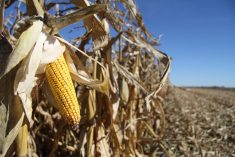SASKATOON — The United States will soon have a glut of soybean meal that could limit crush expansion and renewable diesel production in that country.
Canada’s canola sector will be wrestling with the same issue, but the consequences will not be as dire, says an industry official.
Related stories:
- Experts bearish on soybean crush, export demand
- U.S. Grain/Oilseed Review: Good conditions equal price declines
The U.S. exported a record 14.52 million tonnes of soybean meal in 2023-24, up nine percent from the previous year.
Read Also

Farm Credit Canada partners with major Toronto innovation hub
A FCC parntership with MaRS Discovery District aims to solve technology problems in food supply chains.
The strong export program was due to increased domestic soybean crush and an “historic drought” in Argentina that started in 2022-23, according to a recent report by the U.S. Department of Agriculture’s Foreign Agricultural Service (FAS).
Argentina is the world’s leading exporter of soybean meal. The country’s production of the feed ingredient fell 22 per cent in 2022-23.
“The impacts of the drought continued to support U.S. soybean meal exports through the first half of 2023-24, as Argentine crush did not recover to pre-drought levels until March 2024,” said the FAS.
Now that Argentina’s production has recovered to normal levels, there likely won’t be enough growth in global consumption of the product for both expanding U.S. exports and a recovery in Argentine supplies.
“U.S. crush and renewable diesel growth could be limited by the ability to find an outlet for surplus soybean meal,” the FAS stated in its report.
Domestic disappearance of U.S. soybean meal is expected to grow by 700,000 tonnes per year during the next decade.
Global soybean imports are projected to grow by slightly more than one million tonnes per year over that same timeframe.
Assuming the U.S. captured all that growth, there would be a market for an additional 1.7 million tonnes of soybean meal per year, which would equate to 400,000 tonnes of additional soybean oil production.
However, the growth in U.S. soybean oil consumed for biodiesel and renewable diesel was 600,000 tonnes in 2022 and 1.1 million tonnes in 2023.
“Soybean oil cannot continue to fuel renewable diesel production growth at current rates during the next few years without major changes to global soybean demand, shifts in exporter market shares or low supplies in other exporting countries,” said the FAS.
Chris Vervaet, executive director of the Canadian Oilseed Processors Association, said Canada will have an additional three million tonnes of canola crush capacity by the end of 2025.
Assuming the industry will be running at 90 per cent capacity, that will result in an additional 1.5 million tonnes of canola meal production, a 24 per cent increase over the record 6.2 million tonnes produced in 2023.
“Yah, we’ve got a lot of meal coming down the pike here in the very near future,” he said.
“It’s safe to say that there are some challenges ahead of us similar to those that are highlighted in the report that the USDA put together.”
However, the ramifications of the supply/demand imbalance won’t be as dire as they are south of the border because canola is 43 per cent oil, while soybeans are 20 per cent oil.
“The soybean crushers are impacted a lot more than canola crushers,” said Vervaet.
“That’s just the fact of the business. We crush for oil; they crush for meal.”
However, it is still a potential looming problem for the canola sector. Finding markets for that additional meal is a top priority for processors and everybody in the value chain.
“It’s something that we’re all talking about and we’re actually starting to work on,” he said.
The dairy sector in the United States will remain the “bread and butter” market for Canada.
The hope is that China will purchase more for its dairy industry and its “massive” aquaculture sector and that other new markets emerge in the Indo-Pacific region.
“Overall, I think we are optimistic,” he said.
Vervaet also noted that as Canada’s canola seed exports contract due to increased demand from domestic crushers, the crush industries in foreign markets will slow down and they will be forced to import meal from Canada.
The FAS noted that there are going to be price ramifications associated with the excess soybean meal production. Exporters will reduce prices rather than allow the product to spoil in storage.
“In the long run, however, if global soybean meal supplies outpace global consumption and the United States is not able to take market share from Argentina and Brazil, both crush and possibly renewable diesel production will be constrained by an inability to dispose of soybean meal,” it stated in the report.
Of course, the U.S. has other feedstock options. Imports of animal fat and vegetable oil more than doubled from 2020 to 2023, led by imports of used cooking oil from China.
Those imports are expected to get an “additional policy bump” starting in January 2025, when the U.S. government transitions from a blender’s tax credit to a producer’s tax credit.
“The tax credit will only apply to biomass-based diesel that is produced in the United States,” said the FAS.
“Thus, demand for biofuel imports is expected to drop substantially, driving even greater imports of fats and oils to U.S. refineries to produce these biofuels domestically.”
The U.S. imported more than 800 million gallons of biodiesel and renewable diesel in 2023, so there is a “substantial opportunity” for a bump in vegetable oil and animal fat imports, especially for lower carbon intensity feedstocks like tallow and used cooking oil.
Vervaet said Canada’s canola sector is having a tough time sorting through the potential ramifications of the shift from a blender’s credit to a producer’s credit.
“We’re still making heads or tails of that in terms of what the implications are, what does that mean for trade flows from Canada to the U.S.?” he said.
Contact sean.pratt@producer.com
















